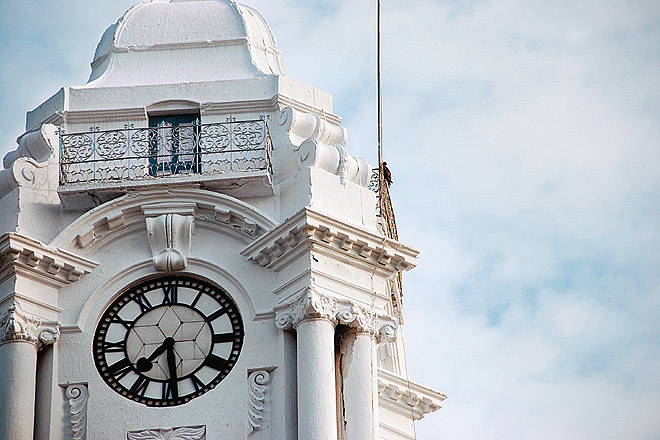When Scotsman Peter Orr moved to Chennai (then Madras Presidency) in the mid-nineteenth century, he must have
It is important to remember P. Orr (if not his sons) today since his name is etched on many of the clock towers in Chennai. Of the several installed by the British government in the early twentieth century, barely a handful survive in good condition. At an age when wristwatches were unaffordable and mobile phones not even a distant dream, these towers served a clear purpose.
It is fascinating to think of all the global influences on these towers: the art deco style from New York, the clock mechanisms from London and a scuffle between Madras Time and Bombay Time that resulted in a compromise of GMT + 5½ hours. One cool morning (by Chennai standards) I set off for a clock tower walk with Chandrachoodan Gopalakrishnan, who conducts regular photo walks in Chennai. First on the list is the one at Royapettah, with its distinct art deco style that was all the rage in the 1920s when it was built. Of the standalone clock towers in Chennai, this is perhaps the only one that is maintained well and always in perfect working condition.
We walk across to Pycrofts Road — now called Bharatiyar Salai, after poet and freedom fighter Subramaniya Bharatiyar who lived on this street — which stretches all the way to the ancient temple precinct of Triplicane. There are several more art deco buildings on this stretch, many of them in ruins. We cross Siva Mani House where a board says that Netaji Subhash Chandra Bose stayed there. And close to that is the imposing Amir Mahal with its deep-red façade, home to the nawab of Arcot.
Apart from this one, most of the clock towers were built in North Madras in the areas around Fort St George, where the seat of British administration was located. That part of the city is home to a large North Indian, Gujarati and Marwari community; to walk through its narrow lanes is to peek into a way of life very different from the rest of Chennai.
The tower at Mint is not working now but Mint Street, almost four kilometres long and said to be the longest road in Chennai, makes up for the long trek up to this area. It once held the British mint and was the commercial heart of the city. It was also home to the publishing industry; the first editions of The Hindu were printed in a local press in the 1880s.
At this time in the morning, the street is just beginning to wake up. Evenings are better for pottering around, when shopkeepers are less testy about their boni (first transaction of the day). The street is ideal for a food walk, a well-kept secret in Chennai. There is Novelty Tea Stall, known to make a mean pav bhaji and some of the best samosas, kachoris and chaat in the city. Then there is Cheena bhai’s oothappam shop, Kakada Sweets known for its onion kachori and to wash it all down with a glass of badam milk, Kamal Chaat House.
We then move on to neighbouring Purasawalkam, still a major street shopping destination, despite the glitter of the omnipresent malls. The clock here, in an area called Doveton, is functional and there has been some recent activity to spruce it up. The main attraction in Purasawalkam is the beautiful 2,000-year-old Gangadeeswarar temple, where legend has it that the temple well never dries up (slightly implausible in perpetually water-short Chennai).
Chandrachoodan remembers reading that there are sixteen standalone clock towers in Chennai but nobody seems to know all of them. City historian V. Sriram mentions two more in Tiruvottiyur and Choolai, both out of commission now. Apart from these, there are several functional clocks on public and private buildings including Chennai Central Station, Ripon Building (which houses the Corporation Office), the P. Orr & Sons shop, Spencer’s Plaza and Madras University. Chennai-ites whizz past — as much as is possible in this still laidback city — these buildings every day but barely spare the clocks a glance.
Once perhaps symbols of British efficiency and punctuality, these clock towers have now lost their relevance, and at best serve as landmarks. “And remember, time itself is not such an important concept to Indians,” says Sriram. I nod, thinking of Indian Flexible Time.
To take this tour, email [email protected] or call 9884467463. There are also several heritage walks organised by citizens’ groups as part of the Madras Day celebrations in mid-August every year. Look out for detailed programmes on http://madrasday.blogspot.in
P. Orr & Sons
travelogues
Leave a Reply
You must be logged in to post a comment.


